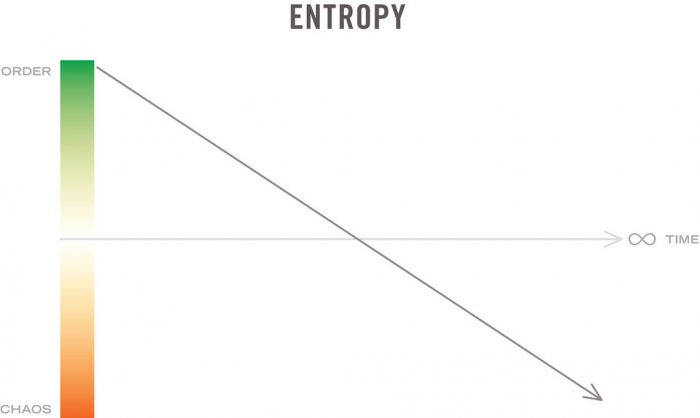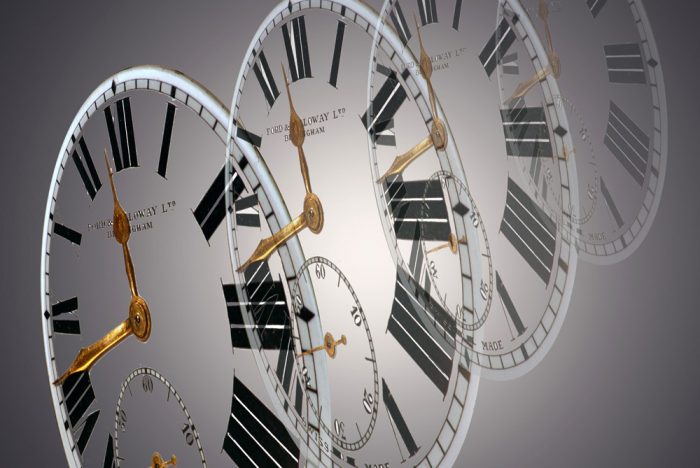
Does the arrow of time still point forward even in quantum systems? A new experiment seems to imply yes, quantum systems obey the arrow of time—at least most of the time. A new study from researchers at Washington University in St. Louis ran an experiment observing the forward and backward time trajectory of a superconducting qubit, which confirmed that quantum systems still abide by the second law of thermodynamics like macroscopic systems do. The new study seems to establish a consistency between microscopic and macroscopic measurement dynamics.
The experiment proceeded by creating a simulation of the statistical trajectory of a qubit through space, then playing the data backward to see which trajectory, the trajectory forward or backward in time, was more likely. According to the second law of thermodynamics, all physical systems show an increase in entropy over time. By playing the data backward, the researchers determined that entropy only increased in the future direction, thus establishing that quantum systems abide by the second law of thermodynamics, at least in most situations. The experiment is novel in its use of new statistical techniques for predicting the time-evolution of quantum systems. The new study can be read in full on the pre-print publication site arXiv.
The Arrow Of Time And Entropy
If there is one physical principle that seems unassailable it is the presence of the arrow of time. The phrase “arrow of time” refers to the ubiquitous observation that time only seems to flow in one direction—from past to future. In the macroscopic domain—the world of things like tables, chairs, trees, and humans, time is only observed ever going forward. This observation seems at odds with how time is treated in physics. For many physicists, time is viewed as a fourth dimension, analogous to the three spatial dimensions. However, whereas the three spatial dimensions are isotropic, meaning they have no privileged direction, time seems to have a privileged direction. Moreover, fundamental physical laws seem to be time-reversible, meaning that they still hold no matter if you “run the clock backward” so to speak.
Many physicists have offered an explanation for the seeming anisotropy of time. According to this idea, the perceived arrow of time is a result of the second law of thermodynamics. According to the second law, sometimes called the law of entropy, all systems show an increase in disorder over time. This is most obviously seen on a macroscopic scale. When fire burns wood it vaporizes it and turns it to smoke; we never see the smoke condense back into a solid block of wood. Likewise, we only ever see a ball sailing through a window causing it to shatter into many pieces we never see the ball travel through a broken window and reassemble itself. In other words, the second law is what allows us to distinguish the time-direction of a certain process. The direction which shows an increase in entropy is in the direction of past to future. Physicists have attempted to devise experiments and thought experiments to find a flaw in the second law, but to no avail so far.

The second law of thermodynamics states that entropy increases over time. Credit: “Entropy – A graph” by Kristian Bjornard via Flickr CC-BY-SA 2.0
When studying microscopic systems, the above observations are not as clear. When watching a single smoke particle being buffeted around the air, it is hard to tell if the video is playing forward or backward. It is only when you observe the cloud of gas on a macroscopic scale that entropy becomes apparent. It would be astronomically improbable for all the gas particles to tend to concentrate instead of diffusing through a space, but you cannot make that judgment by just looking at the behavior of one particle.
Entropy And Quantum Systems
The problem of determining an arrow of time is difficult in quantum mechanical systems for many reasons. Primary among them is the fact that quantum systems are greatly affected by the measurement process. Unlike macroscopic systems in which the effects of measurement are negligible, quantum systems are so small and volatile that the very act of measurement causes changes to the system. Second, quantum measurements by their very nature are probabilistic. Any model of a quantum system cannot predict with exact precision the position or momentum of any given particle; it can only give the probability that a particle will be measured with a particular position or momentum.
There is a way to get around these issues though. It is possible to model the trajectory of a quantum system by measuring the indirect effects it has on the surrounding environment. By observing statistical changes in the environment surrounding quantum systems, scientists can work backward to build a model of the trajectory of a quantum system over time. The upshot of this process is that is indirect and is not achieved by directly interacting with the quantum system. Thus, the information contained in the quantum system is not destroyed via a process of direct measurement.
So proceeds the study under consideration. The researchers experiment proceeded by setting up a simple quantum system consisting of a qubit oscillating at a certain frequency. By stimulating the experimental chamber with microwaves and measuring their perturbation, the researchers were able to determine the state of the qubit by computing the phase shift that was dependent on the qubits initial state. After measuring the state of the microwave probe, the scientists digitized these measurements to receive a set of discrete measurements over a period of time. Using these digitized time-step measurements, the researchers were able to infer the qubit state piece-by-piece and construct a model representing the qubit’s continuous trajectory over time.
The researchers then took their constructed qubit model and calculated the different entropy states of the quantum system ordered forward and backward through time. The total entropy values of these ordered sequences of quantum states were denoted Q where a positive Q (more entropy) indicates a forward trajectory through time and a negative Q (less entropy) signifies a backward trajectory through time.
Next, the researchers set up a simulation of a quantum experiment between three observers, Alice, Bob, and Charlie. By running the experiment using a number of different initial states and measurement processes subject to different parameters, the researchers were able to determine that negative values of Q (less entropy) were more likely to occur for small numerical values of Q. This corresponds to the well-known fact that quantum fluctuations can sometimes produce very small decreases in entropy. However, the researchers also found that for large values of Q, which corresponds to the evolution of Q over a longer period of time, Q values were more likely to be positive, signifying increased entropy. In other words, over longer periods of time, a quantum system is likely to exhibit behavior in line with positive values of Q.
The researchers argue that the explanation for this finding is that calculations about quantum perturbance generally do not factor in the influence of initial conditions on the evolution of quantum systems. According to the researchers, the initial state places a lower boundary on possible values of Q. This sensitivity to initial conditions is a consequence of the unlikelihood of a certain initial state obtaining. To put the point another way, initial values for Q in which the time evolution of Q is likely to be negative correspond to situations where the initial state of the quantum system is itself unlikely. Since these initial states themselves are relatively unlikely, it follows that the overall evolution of the system will tend towards positive values of Q. According to the researchers, the results show “that a statistical arrow of time emerges fundamentally in quantum measurement, where information and backaction result from entanglement with a fluctuating environment.”
Status Of The Second Law of Thermodynamics
The second law of thermodynamics is sometimes referred to as a “statistical law,” meaning that is is a universal generalization that arises out a fundamentally statistical fact. For a sufficiently large system, the vast majority of possible states that the system could be in are states where entropy is greater than the initial state. Therefore, any change to the system is likely to move it from an initial state towards a state of greater entropy.
The question for scientists has been whether this generalization extends to the microscopic quantum world. The current study shows that it is possible to give a characterization of the second law of thermodynamics that is applicable to quantum systems, though it does require a few conceptual revisions. Specifically, it is hard to separate a quantum system from its environment. Quantum systems by their very nature resist strict isolation; in fact, part of what it means to be a quantum system has to do with interactions with the environment in the form of quantum entanglement. The current study shows that by factoring in the influence of the environment on a quantum system, it is possible to recover a version of the statistical law of entropy in the context of quantum systems.










